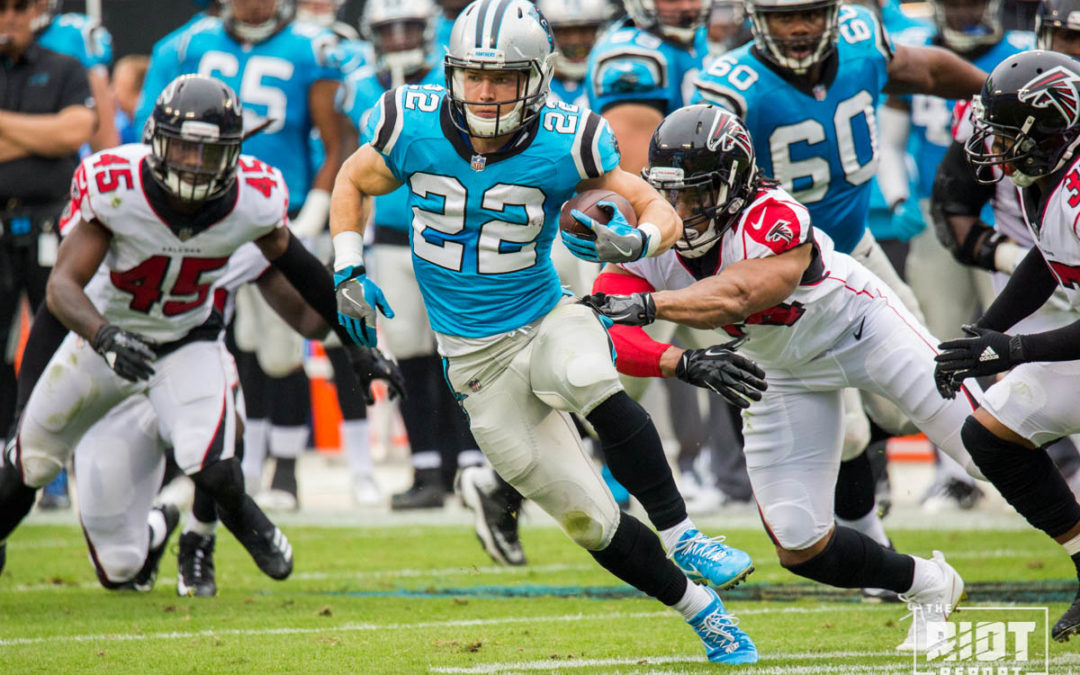The match-up between the Panthers’ number-one defense in the NFL and the Dolphins’ 31st-ranked offense looks to be a somewhat one-sided affair. What might be more uncertain, however, is the contest between the Panthers’ 21st-ranked offense against the Dolphins’ 20th-ranked defense. While NFL teams prepare quite differently for each game, this article hopes to explore how the Panthers’ offense can create an advantage against the Dolphins, and where it might struggle
Running Game
The Panthers’ running game currently ranks 30th in the NFL, despite an unexpected 200-yard effort against the Falcons last week. Given the Dolphins fourth ranked run defense, this would certainly look to be a bad match-up for the Panthers. However, by looking at how the Ravens were able to run the ball against the Dolphins, there are some takeaways for the Panthers’ running game to exploit.
The most obvious takeaway from the Ravens running game was the disparity between the two running backs; Alex Collins averaged well over six yards-per-carry, nearly twice that of Javorius “Buck” Allen. Some would argue that Collins may not be a better running back, but he is also clearly more dependent on speed and agility than power. With that in mind, Monday night could well be another big game from Christian McCaffrey.
What could also play into the disparity between the Ravens’ running backs was where they chose to run. Allen’s carries were almost exclusively between the tackles, with limited success; Collins, by contrast, had nearly half his carries go outside the tackles. While it is hard to make absolute statements about the Dolphins’ defense based off of this, it certainly encourages further examination.
The Ravens were able to gain relatively consistent yardage outside through the use of stretch runs, forcing the Dolphins to retain discipline across the formation, such as on the plays below:
On the first play, Collins is able to spot the Dolphins overpursuing and cuts the ball back inside. On the second, Allen is able to pick up a big gain despite failing to notice the enormous gap inside of him. Stretch plays like this have been mixed in their effectiveness for the Panthers this season, but one area where they had real success against Atlanta was also used to great effect by the Ravens against the Dolphins; the quick toss.
Here, the Ravens get Collins outside quickly, allowing him to take advantage of the perimeter defense by the Dolphins. As mentioned by Sean Mauk in his weekly preview, this bears a striking resemblance to these plays against the Falcons last week.
If the Panthers can use these plays to get outside of the Dolphins defense, there should be hope that they can have success on the ground. The Dolphins defensive line has been effective in stuffing the run so far this season, but the perimeter run defense is a lot more suspect.
Of course, the Panthers cannot run the ball exclusively outside the tackles all game, and while they will have to be judicial about when they look to run the ball inside there are further takeaways from the Dolphins-Ravens game about how the Panthers might be able to maximize the output of the inside running game.
One play which the Ravens ran with reasonable success against the Dolphins was an inside double-trap play. This has a tight end and interior lineman coming across the formation to trap the tackles and create a back-side crease for the running back, as below:
While this play is somewhat high risk, it has the advantage of allowing the tackles to get downfield before making the block. The Panthers have used this blocking pairing of guard and tight end a lot this year, but largely pulling across to create a front-side overload. Where this has fallen short is in the lack of space for the blockers to pull to; the advantage with the play the Ravens run is that the crease is on the back side, and so there is no issue with overfilling the desired running lane.
Additionally, by making 300 pound men play in space, this play works in the running backs favor if the block is missed compared the common match-up with a linebacker. The Panthers might not copy this play exactly, but if they have put in the time in the film room, this could well be a wrinkle that we see on Monday.
Passing Game
The Dolphins were expected to be one of the better passing defenses in the NFL, with their strong defensive line putting pressure on opposing quarterbacks, but while their defensive line hasn’t been poor, the inability to get quick pressure has made their drop-back zone defense susceptible to exploitation by methodical passing games. With the Panthers have struggled at times throwing the ball so far this season, the Dolphins pass defense possesses very little that should scare the Panthers.
Slants are possibly the most universally effective route in football, with the ability to counter both man and zone coverage, and here the Jets use them to great effect against the drop-back zone. With the off defender effectively out of the play against the in-breaking route, all the quarterback needs to do it time the pass between the underneath defenders. Plays like this are not only hugely effective in their base outcome, but the ability to hit the receiver in stride also opens up run-after-the-catch possibilities.
All of the following plays are simple underneath curl routes against the zone coverage. If the quarterback is able to recognize the coverage this should make for easy completions underneath and while these plays have limited big-play potential, they can an extremely effective of moving the chains on a consistent basis. What is also very helpful about routes like this is that they can be run by relatively poor receivers; with Greg Olsen out, Ed Dickson could have a big day with such underneath sit-down routes.
The final way in which the Dolphins passing defense is vulnerable is the deep ball. This is uncommon for a zone defense, but there is enough on tape to question the pure deep speed of the Dolphins’ corners, the most egregious example from early in the season being Byron Maxwell. Robby Anderson is a decent NFL receiver, but the ease with which he gets beyond the defense may have led to Maxwell’s release two days after the game.
Their lack of speed at the cornerback position forces the Dolphins to play off the receiver in order to take away the deep ball which in turn opens up the deep hitch and dig routes, such as on the following play.
While some of the deeper routes put more pressure on the offensive line to pass protect, the combination of deep routes and short slants and curls should allow the Panthers to pick the Dolphins apart while also allowing for the occasional deep ball when protection permits.
The Dolphins defense isn’t a pushover, especially against the inside run, but the dropback zone and questions about perimeter run defense should have the Panthers optimistic about Monday night. There might even be some plays for Alex Armah or Chris Manhertz in there when the Dolphins go to a man look….



